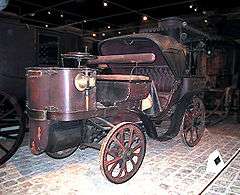Amédée Bollée
Amédée-Ernest Bollée (11 January 1844 – 20 January 1917) was a French bellfounder and inventor who specialized in steam cars. After 1867 he was known as "Amédée père" to distinguish him from his similarly named son, Amédée-Ernest-Marie Bollée (1867–1926).
Biography
Bollée was the eldest son of Ernest-Sylvain Bollée, a bellfounder and inventor who moved to Le Mans in 1842. He became seriously ill in the 1860s and was obliged to delegate the day-to-day running of his businesses to his three sons. Amédée-Ernest was given charge of the bell foundry, while Ernest-Jules (1846–1922) supervised the hydraulic ram business and the youngest son, Auguste-Sylvain Bollée (1847–1906) assumed control of the Éolienne Bollée wind-turbine factory.
Steam vehicles
L'Obéissante


Amédée père manufactured his first steam vehicle in 1873, and in 1875 his L'Obéissante ("The Obedient") made the first road trip between Le Mans and Paris in 18 hours. L'Obeissante carried 12 passengers and had a cruising speed of 30 km/h (19 mph) and a top speed of 40 km/h (25 mph). It was driven by two V-twin steam engines, one for each rear wheel. The original vehicle is preserved in the collection of the Conservatoire National des Arts et Métiers in Paris.
La Mancelle
In 1878, Amédée père designed the Mancelle, which is regarded as the first automobile to be put into series production, 50 being manufactured in all. It possessed such (for the period) advanced features as rear-wheel drive (via shaft to the differential and then via chain to the rear wheels) and independent suspension on all four wheels. The original vehicle is preserved in the collection of the Musée de l'Automobile de la Sarthe.
Marie-Anne
The public demonstrations of L'Obeissante and La Mancelle had secured orders for the Bollée factory, and Amédée père accepted an order for a road train which was completed in 1879. Developing 100 hp, the Marie-Anne had a three-speed gearbox and was capable of towing 35 tons on a 6% slope.[2]
The Marie-Anne was of a similar design to La Mancelle, with a vertical boiler mounted at the rear driving front mounted engines which transmitted their power to the rear wheels via driveshafts and chains. A tender carried coal and water reserves.
La Rapide
La Rapide ("Rapid") was built in 1881 and was noted for achieving a speed of 62 km/h (39 mph). La Rapide grouped the boiler, the engine and the controls at the front of the vehicle, thus making it possible for it to be driven by a single operator.[3]
See also
References
External links
French: